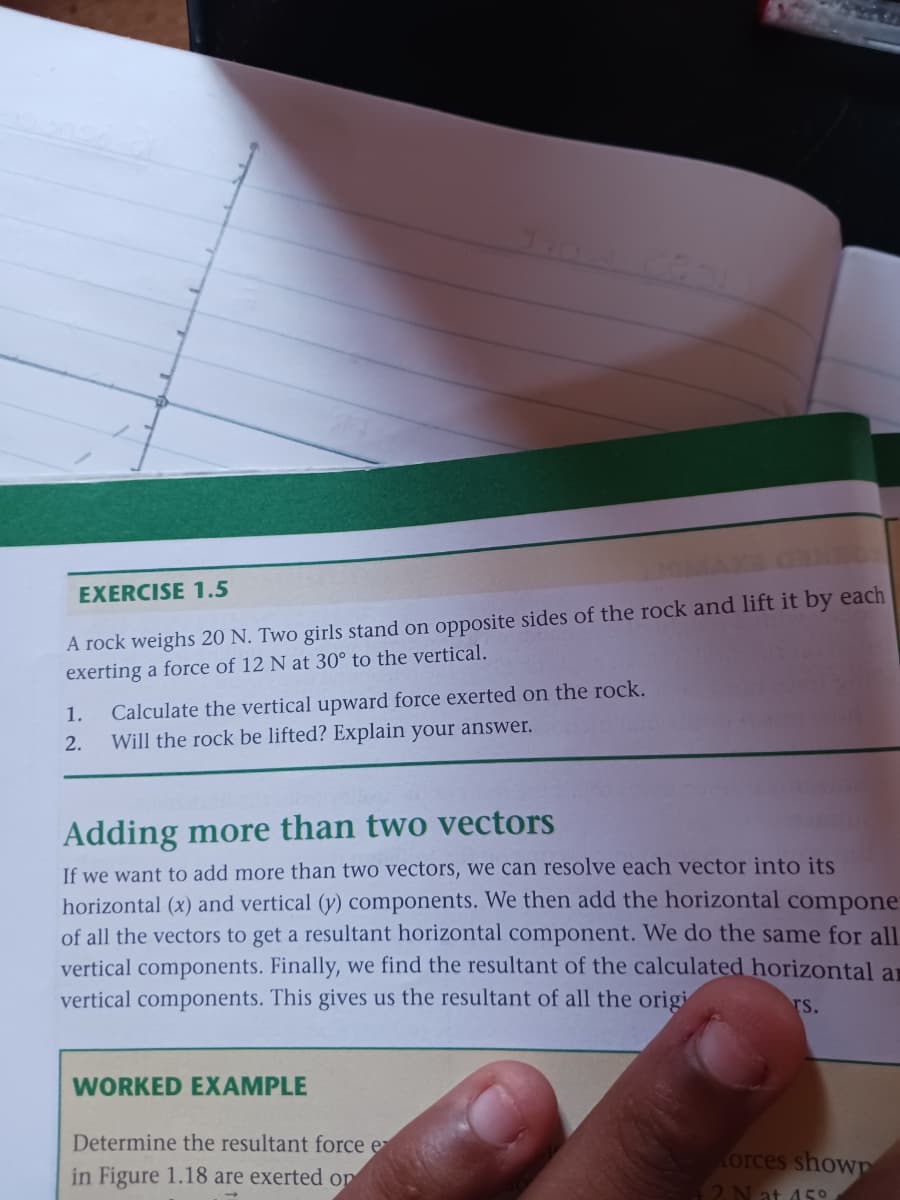EXERCISE 1.5 A rock weighs 20 N. Two girls stand on opposite sides of the rock and lift it by each exerting a force of 12 N at 30° to the vertical. 1. 2. Calculate the vertical upward force exerted on the rock. Will the rock be lifted? Explain your answer.
EXERCISE 1.5 A rock weighs 20 N. Two girls stand on opposite sides of the rock and lift it by each exerting a force of 12 N at 30° to the vertical. 1. 2. Calculate the vertical upward force exerted on the rock. Will the rock be lifted? Explain your answer.
College Physics
11th Edition
ISBN:9781305952300
Author:Raymond A. Serway, Chris Vuille
Publisher:Raymond A. Serway, Chris Vuille
Chapter1: Units, Trigonometry. And Vectors
Section: Chapter Questions
Problem 1CQ: Estimate the order of magnitude of the length, in meters, of each of the following; (a) a mouse, (b)...
Related questions
Question
100%

Transcribed Image Text:EXERCISE 1.5
Xa
A rock weighs 20 N. Two girls stand on opposite sides of the rock and lift it by each
exerting a force of 12 N at 30° to the vertical.
1.
2.
Calculate the vertical upward force exerted on the rock.
Will the rock be lifted? Explain your answer.
Adding more than two vectors
If we want to add more than two vectors, we can resolve each vector into its
horizontal (x) and vertical (y) components. We then add the horizontal compone
of all the vectors to get a resultant horizontal component. We do the same for all
vertical components. Finally, we find the resultant of the calculated horizontal a
vertical components. This gives us the resultant of all the origi
TS.
WORKED EXAMPLE
Determine the resultant force e
in Figure 1.18 are exerted or
orces showp
2. N at 45°
Expert Solution
This question has been solved!
Explore an expertly crafted, step-by-step solution for a thorough understanding of key concepts.
Step by step
Solved in 3 steps with 3 images

Knowledge Booster
Learn more about
Need a deep-dive on the concept behind this application? Look no further. Learn more about this topic, physics and related others by exploring similar questions and additional content below.Recommended textbooks for you

College Physics
Physics
ISBN:
9781305952300
Author:
Raymond A. Serway, Chris Vuille
Publisher:
Cengage Learning

University Physics (14th Edition)
Physics
ISBN:
9780133969290
Author:
Hugh D. Young, Roger A. Freedman
Publisher:
PEARSON

Introduction To Quantum Mechanics
Physics
ISBN:
9781107189638
Author:
Griffiths, David J., Schroeter, Darrell F.
Publisher:
Cambridge University Press

College Physics
Physics
ISBN:
9781305952300
Author:
Raymond A. Serway, Chris Vuille
Publisher:
Cengage Learning

University Physics (14th Edition)
Physics
ISBN:
9780133969290
Author:
Hugh D. Young, Roger A. Freedman
Publisher:
PEARSON

Introduction To Quantum Mechanics
Physics
ISBN:
9781107189638
Author:
Griffiths, David J., Schroeter, Darrell F.
Publisher:
Cambridge University Press

Physics for Scientists and Engineers
Physics
ISBN:
9781337553278
Author:
Raymond A. Serway, John W. Jewett
Publisher:
Cengage Learning

Lecture- Tutorials for Introductory Astronomy
Physics
ISBN:
9780321820464
Author:
Edward E. Prather, Tim P. Slater, Jeff P. Adams, Gina Brissenden
Publisher:
Addison-Wesley

College Physics: A Strategic Approach (4th Editio…
Physics
ISBN:
9780134609034
Author:
Randall D. Knight (Professor Emeritus), Brian Jones, Stuart Field
Publisher:
PEARSON